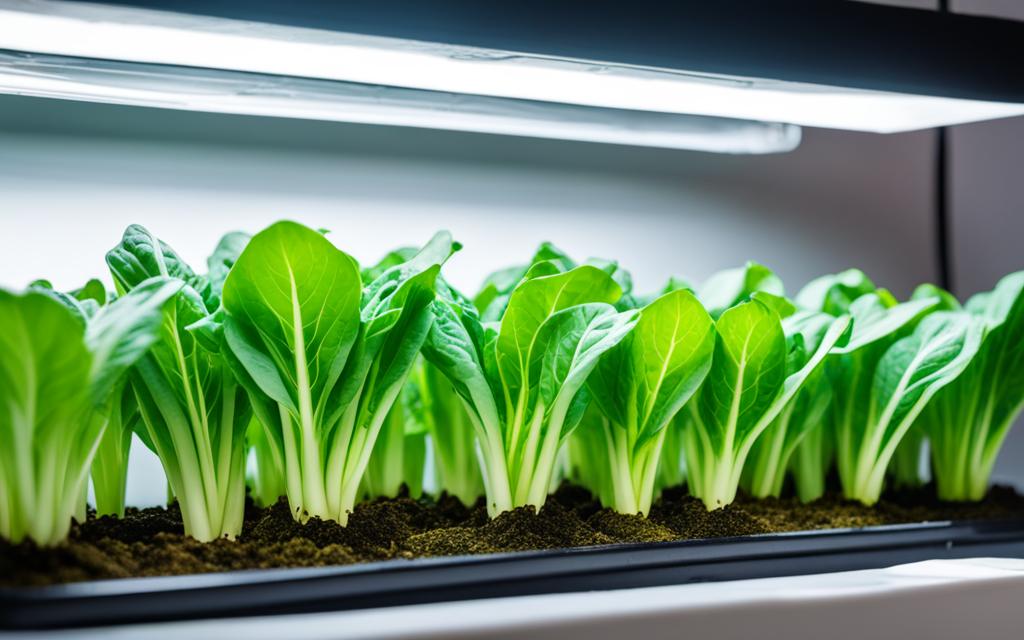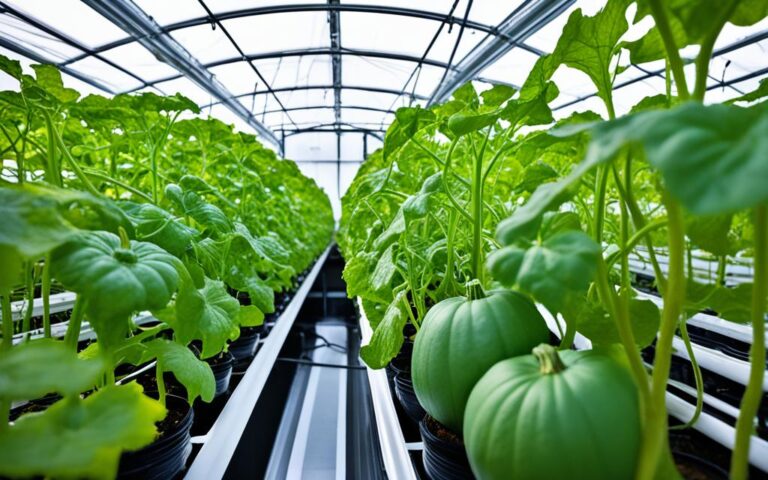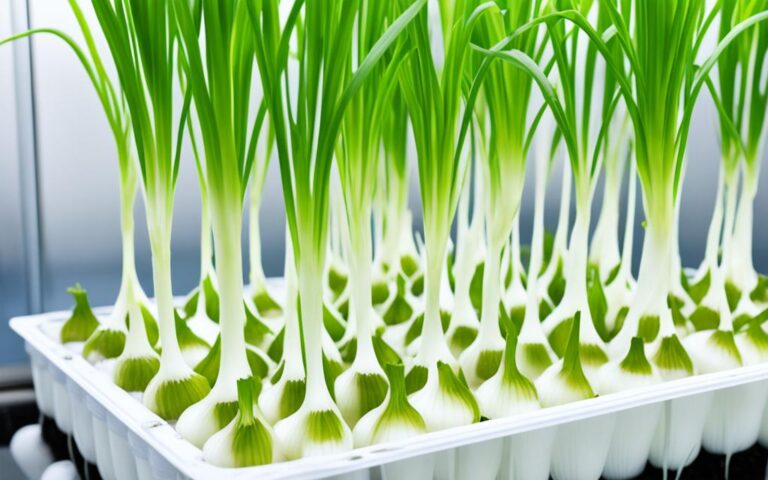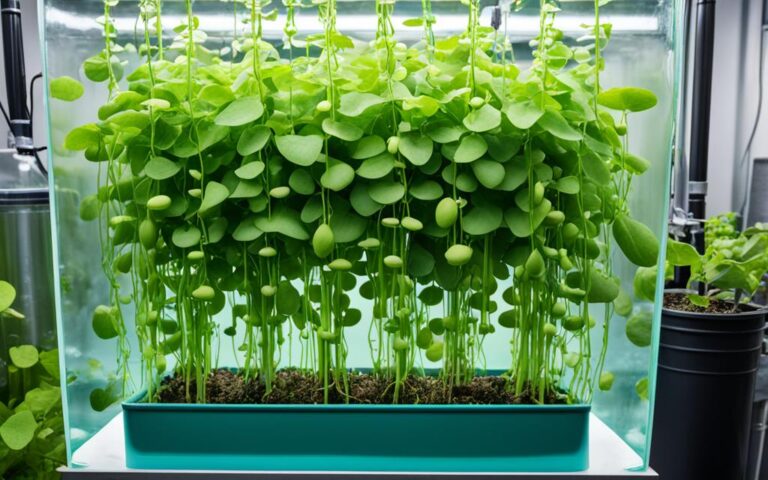Hydroponic Pak Choi: Grow Fresh Greens Indoors
Did you know that just one square foot of hydroponic Pak Choi can yield up to 10 pounds of fresh, nutrient-rich greens per year? This versatile Chinese cabbage is quickly becoming a favorite among indoor gardeners. Pak Choi, also known as Bok Choy or Chinese Cabbage, is a popular vegetable commonly used in Asian cuisine. It is a fast-growing, renewable crop that can thrive in hydroponic systems, making it an excellent choice for indoor gardening.
Pak Choi is a cool-season plant that prefers mild temperatures. It can be successfully grown using various hydroponic methods, such as wick systems, deep water culture (DWC), and ebb and flow (flood and drain). This article will guide you through the process of growing hydroponic Pak Choi, from selecting the right varieties to maximizing yields and productivity.
Key Takeaways
- Hydroponic Pak Choi can yield up to 10 pounds of fresh greens per square foot per year
- Pak Choi is a fast-growing, renewable crop that thrives in hydroponic systems
- Pak Choi can be grown using various hydroponic methods, including wick systems, DWC, and ebb and flow
- The article will cover selecting the right Pak Choi varieties, setting up a hydroponic system, and maximizing yields
- Maintaining the proper pH and nutrient levels is crucial for successful Pak Choi cultivation in a hydroponic environment
Introduction to Growing Hydroponic Pak Choi
Hydroponic pak choi is perfect for indoor gardeners wanting fresh, nutrient-rich leafy greens all year. It belongs to the Brassica family, offering a mild, sweet taste and crunchy texture. With hydroponic systems, you control the growing conditions for fast growth and steady harvests.
Growing pak choi hydroponically lets you cultivate it indoors. Hydroponics creates a perfect environment, avoiding traditional soil gardening limits. You get fresh, high-quality pak choi any season, without worrying about the outdoors. Plus, hydroponics reduces pests and diseases by keeping plants away from soil-borne issues.
“Hydroponic gardening is a game-changer for indoor leafy greens like pak choi. You can produce a steady supply of fresh, nutrient-dense produce all year long.”
Hydroponic pak choi is also very efficient, often giving more produce per square foot than traditional methods. It’s great for small-space gardeners or those wanting to make the most of their indoor gardening space.
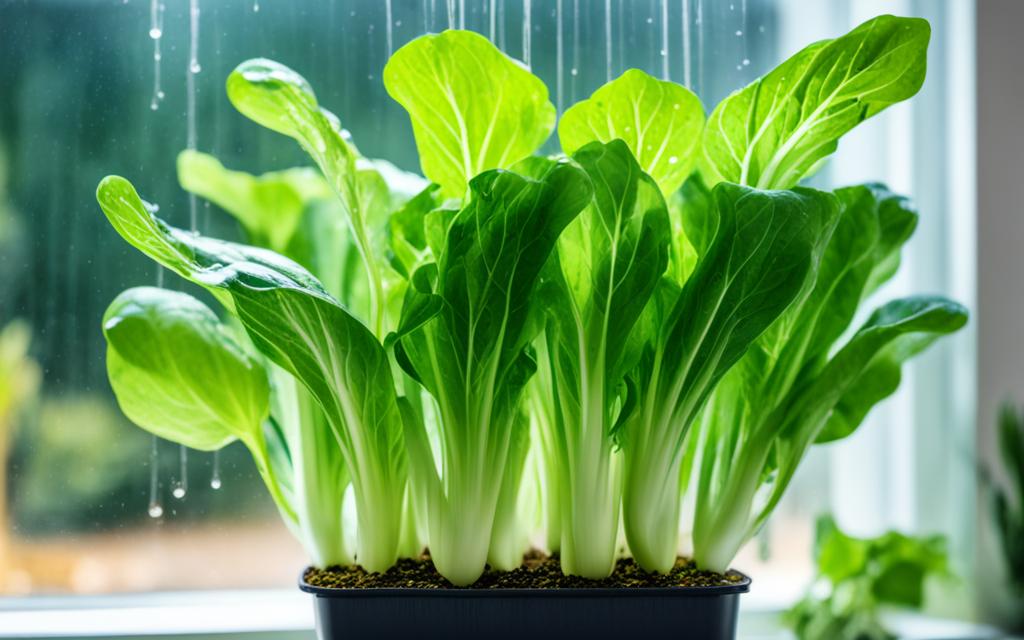
Next, we’ll explore more about growing hydroponic pak choi. We’ll cover variety selection, system setup, nutrient needs, and how to harvest. This guide is for both experienced indoor gardeners and beginners in hydroponics. It will help you grow healthy pak choi plants at home.
Varieties of Pak Choi for Hydroponic Gardens
When you grow hydroponic pak choi indoors, you can choose from many varieties. Each one has its own look and taste. You can pick from green-stemmed, red-leaf, or white-stem types to enhance your garden.
Green Stemmed Varieties
The green-stemmed pak choi are a classic choice. They taste mild and slightly sweet. These greens are great for sautéing, adding to stir-fries, or eating raw in salads.
They’re also perfect for hydroponics because they’re strong and easy to grow indoors.
Red Leaf Varieties
For a splash of color, try red leaf pak choi. They have deep purple or burgundy leaves. These greens are not just pretty; they also taste slightly peppery.
This adds a unique flavor to your dishes.
White Stem Varieties
The white stem pak choi are delicate and sweet. They have soft stems and crisp leaves. Chefs and home cooks love them for their mild taste and juicy texture.
Exploring the different hydroponic pak choi varieties lets you create a garden that suits you. Choose from green-stemmed, red-leaf, or white-stem types. Your hydroponic pak choi will be a hit in the kitchen.
Setting Up a Hydroponic System for Pak Choi
Growing delicious and nutrient-rich pak choi is easy with hydroponic systems. Pak choi, part of the cabbage family, does well in many hydroponic setups. Let’s look at three top options for your pak choi.
Wick Systems
Wick systems are simple and low-maintenance for pak choi. They use capillary action to give water and nutrients to the roots. These systems are great for beginners and need little upkeep.
Deep Water Culture (DWC)
The DWC system keeps pak choi roots in a nutrient-rich solution. This leads to fast growth and lush leaves. It’s perfect for those who want a hands-off hydroponic method. DWC systems produce healthy and vibrant pak choi.
Ebb and Flow (Flood and Drain)
The Ebb and Flow system balances water, nutrients, and air for pak choi. It floods the roots with solution, then drains it. This method helps roots grow strong and keeps plants healthy.
Think about each system’s needs and benefits to pick the best for your pak choi. Whether you go with a wick system, DWC, or Ebb and Flow, you’ll enjoy a harvest of fresh, tasty pak choi from your hydroponic garden.
Germination and Seedling Care
For a successful hydroponic Pak Choi harvest, it’s key to focus on hydroponic pak choi germination and seedling care. Pak Choi seeds germinate in 4 to 7 days at a steady temperature of 50-80°F (10-27°C). The best temperature is 68-75°F (20-24°C). The right growing medium, moisture, and light during the pak choi seedling care stage give your Pak Choi plants a strong start.
When starting pak choi from seed, use a growing medium that drains well, like seed starting mix or coco coir. Keep the medium moist but not too wet. Give the seedlings bright, indirect light for 12-16 hours a day. If natural light is lacking, consider using a grow light.
After the Pak Choi seedlings sprout, increase their light and start feeding them a mild nutrient solution. Keep the pH between 6.0 and 6.8 for best nutrient absorption. Watch the seedlings for stress or disease signs and fix any problems quickly for a healthy start to your Pak Choi crop.
| Germination Requirement | Optimal Range |
|---|---|
| Temperature | 68-75°F (20-24°C) |
| Growing Medium | Well-draining seed starting mix or coco coir |
| Moisture Level | Consistently moist, but not waterlogged |
| Lighting | Bright, indirect light for 12-16 hours per day |
| pH Range | 6.0 – 6.8 |
By following these hydroponic pak choi germination and pak choi seedling care tips, you’ll set your Pak Choi plants up for a healthy and productive hydroponic season.
Transplanting Pak Choi into Your Hydroponic System
When your Pak Choi seedlings have 2-3 true leaves, it’s time to move them to your hydroponic system. It’s important to handle the roots carefully to reduce stress. Make sure to plant the seedlings at the same depth they were before for a smooth transition.
For your hydroponic pak choi plants to grow well, a smooth transition is key. By following these easy steps, you can move your transplant pak choi into your hydroponic setup successfully. This way, your fresh greens will flourish.
Tips for Transplanting Pak Choi Seedlings
- Carefully remove the seedlings from their current growing medium, taking care to disturb the roots as little as possible.
- Plant the seedlings in your hydroponic system at the same depth they were growing previously.
- Gently press the growing medium around the roots to ensure good contact with the nutrient solution.
- Water the transplanted seedlings immediately to help them establish in the new environment.
- Monitor the plants closely in the first few days after transplanting, adjusting the nutrient solution or environmental factors as needed.
By following these best practices for moving pak choi seedlings into your hydroponic system, you can ensure a successful transition. This sets your Pak Choi plants up for continued growth and productivity.
Nutrient Requirements for Hydroponic Pak Choi
Getting the right balance of nutrients is key for growing hydroponic Pak Choi well. Pak Choi is a leafy green that loves a slightly acidic to neutral soil. It also needs certain levels of electrical conductivity (EC) and total dissolved solids (TDS) for best growth.
pH Range
Pak Choi does best in a pH of 6.0 to 7.0. This range makes sure it can get the nutrients it needs. It stops nutrient lockout, letting the plants take in the hydroponic pak choi nutrients they require.
EC/TDS Range
The best EC (Electrical Conductivity) for Pak Choi is 1.5 to 2.0. This means the TDS (Total Dissolved Solids) should be 1050 to 1400 ppm. Keeping these levels right helps your Pak Choi plants grow strong and healthy in the hydroponic setup.
It’s important to keep an eye on and adjust the pH and EC/TDS in your hydroponic setup. This ensures your Pak Choi plants do well and reach their best potential.
“Proper nutrient management is the foundation for bountiful hydroponic Pak Choi harvests.” – Hydroponic Gardening Expert
Light and Temperature Needs
Pak choi plants need specific light and temperature conditions to do well in hydroponics. They require 10-12 hours of light each day. If sunlight is scarce, hydroponic pak choi lighting can help. The best temperature for them is between 64°F and 68°F (18°C to 20°C). They can also handle temperatures up to 95°F (35°C) and as low as 27°F (-3°C).
Keeping the light and temperature steady is key for healthy growth and to stop the plants from flowering too early. This is very important when growing pak choi indoors, where you can control the environment better.
- Provide 10-12 hours of light per day for optimal growth
- Maintain an ambient temperature range of 64°F–68°F (18°C–20°C)
- Ensure consistent light and temperature to avoid premature bolting
“Proper lighting and temperature are critical factors in successfully growing healthy, productive pak choi in a hydroponic system.”
By paying close attention to the hydroponic pak choi lighting and pak choi temperature requirements, growers can make the best environment for these greens. Even when growing pak choi indoors, they can thrive.
Pruning and Harvesting hydroponic Pak Choi
Hydroponic pak choi can be harvested in two main ways: continuous and full plant harvest. Knowing how to do each method helps growers get the most from their plants. This ensures a steady supply of fresh, tasty greens.
Continuous Harvest Method
This method lets you pick individual leaves from the pak choi plant, while the rest keeps growing. It gives you a steady flow of fresh greens. You can choose which leaves to take without harming the plant.
It’s important to prune the plant well. Remove any yellow or damaged leaves to help the plant grow stronger and longer.
Full Plant Harvest
Or, you can harvest the whole plant at once. This gives you a big batch of pak choi but means waiting longer for the next crop. It’s great when you need a lot of pak choi for a big event.
| Harvest Method | Advantages | Disadvantages |
|---|---|---|
| Continuous Harvest |
|
|
| Full Plant Harvest |
|
|
No matter the harvesting method, good pruning is key. It keeps the plants healthy and boosts their productivity in a hydroponic garden.
Common Pests and Diseases
Keeping your hydroponic Pak Choi healthy means watching out for pests and diseases. Hydroponic systems can face many issues that hurt your Pak Choi plants’ growth and yield. Knowing these problems and acting early can help you get a great harvest.
Pests to Watch Out For
Aphids and caterpillars are two pests that often bother hydroponic Pak Choi. Aphids are tiny insects that can quickly spread and harm your plants. Caterpillars can eat the leaves and stems. It’s important to check your plants often and act fast to stop these pests.
Managing Pests Organically
Instead of using harsh chemicals, try natural ways to fight hydroponic pak choi pests. You can remove pests by hand, use beneficial insects, or organic insecticides. These methods help control pests without harming your plants or the environment.
Preventing and Treating Diseases
Hydroponic Pak Choi can also get sick. Look out for signs like colored leaves, slow growth, or infections. Keeping your system clean, checking the pH and nutrients, and fixing problems quickly can stop diseases from spreading.
| Common Hydroponic Pak Choi Pests | Symptoms of Pak Choi Diseases |
|---|---|
|
|
By being careful and using pest management for hydroponic pak choi, you can keep your Pak Choi healthy and productive. Regular checks, using natural methods, and keeping your growing area clean are important for a good harvest.
Hydroponic Pak Choi Growth Timeline
Growing hydroponic pak choi is rewarding, thanks to its quick growth and short time to maturity. Typically, pak choi hydroponic growth is ready in 45 to 60 days after transplanting. This makes it perfect for indoor gardeners wanting fresh greens all year.
Watching the plant grow from germination to harvest helps plan for each stage. Knowing when hydroponic pak choi is ready lets you harvest it at the best time. This ensures a steady supply of this versatile leafy green.
| Growth Stage | Timeline |
|---|---|
| Germination | 5-7 days |
| Seedling | 10-14 days |
| Transplanting | 14-21 days |
| Mature Leaves | 45-60 days |
| Time to Harvest | 45-60 days |
Knowing the pak choi hydroponic growth timeline helps improve your growing methods. With the right care, your indoor hydroponic pak choi garden will give you fresh greens all year.
Maximizing Yields and Productivity
For any hydroponics enthusiast, the goal is to get the most out of their pak choi plants. To boost your hydroponic pak choi yields and increase pak choi productivity, keep a close eye on the growing conditions. This means making sure everything is just right for your plants.
First, make sure the nutrient levels, pH, and EC/TDS ranges are perfect. Keeping an eye on these and adjusting them as needed will help your hydroponic pak choi plants grow strong. Also, the right light and temperature settings are key for optimizing hydroponic pak choi growth.
How you space, prune, and harvest your plants also matters a lot. By arranging your plants well and pruning them, you can make the most of your space. This leads to healthier, bigger plants.
Pruning your pak choi plants keeps them looking neat and helps them focus on growing bigger, tastier leaves. Also, choosing the right way to harvest, like continuous or full plant harvest, can give you a steady supply of fresh greens.
“By meticulously attending to the details of your hydroponic system and cultivation practices, you can unlock the true potential of your pak choi and enjoy bountiful, consistent harvests.”
Remember, getting the most out of your hydroponic pak choi takes effort and attention. With the right methods and careful attention, you can make your hydroponic pak choi growth thrive. This leads to a rewarding harvest full of delicious, healthy greens.
Conclusion
Growing hydroponic Pak Choi is a rewarding way to enjoy fresh, nutrient-rich greens all year. By learning about growing hydroponic pak choi, you can have a thriving indoor garden. This guide has given you the knowledge to grow Pak Choi at home.
Enjoy the benefits of hydroponic pak choi and taste the fresh, crisp flavor of your own Pak Choi. With care and attention, you can have a lot of this nutritious green. It’s great for both experienced gardeners and beginners.
Start using your indoor space for growing hydroponic pak choi. Hydroponic gardening is sustainable and lets you enjoy the taste of your own Pak Choi.
